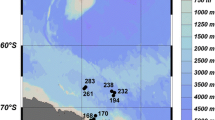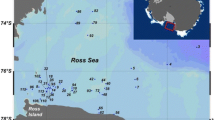Summary
Micronekton and macrozooplankton assemblages (0–1000 m) were sampled from the open ocean in the vicinity of marginal ice zones in the southern Scotia and western Weddell Seas using midwater trawls. Small regional differences in species composition were found in the differing hydrographic settings with the Scotia Sea being slightly more diverse. Most species exhibited broad vertical ranges with no distinct pattern of vertical movement. Exceptions were mesopelagic fish and Salpa thompsoni which undertook diel vertical migrations. Biomass was high (2.4–3.1 g DW/m2), comparable to Pacific subarctic waters. Euphausia superba and Salpa tompsoni were the numerical and biomass dominants, representing over 50% of the total numbers and standing stocks. In terms of biomass, euphausiids were the most important group at shallow depths (0–200 m) but were surpassed by salps in the Scotia Sea and mesopelagic fish in the Weddell Sea when all depths down to 1000 m were considered. Pelagic fish biomass (3.3–4.4 g WW/m2) greatly exceeded published estimates for birds (0.025–0.070 g WW/m2), seals (0.068–0.089 g WW/m2) and whales (0.167 to 0.399 g WW/m2), making mesopelagic fish the most prevalent krill predators in the Antarctic oceanic system.
Similar content being viewed by others
References
Ainley DG (1985) Biomass of birds and mammals in the Ross Sea. In: Siegfried WR, Condy PR, Laws RM (eds) Antarctic nutrient cycles and food webs. Springer, Berlin Heidelberg, pp 498–515
Andriashev, AP (1965) A general review of the Antarctic fish fauna. In: Mieghem J, Oye P (eds) Biogeography and ecology of Antarctica. Junk, The Hague, pp 491–550
Asencio G, Moreno CA (1984) Dieta y selectividad alimentaria de Protomyctophum bolini Fraser-Brunner (Pisces; Myctophidae) en el paso Drake (Antarctica). Ser Cient INACH 31:85–96
Bekker VE, Evseenko SA (1987) Distribution of mesopelagic fishes and biogeographic borders in the southern Pacific Ocean in January–February 1985. J Ichthyol 27:9–20
Bengtson JL, Laws RM (1985) Trends in Crabeater seal age at maturity: An insight into Antarctic marine interactions. In: Siegfried WR, Condy PR, Laws RM (eds) Antarctic nutrient cycles and food webs. Springer, Berlin Heidelberg, pp 669–675
Clarke A (1985) Energy flow in the Southern Ocean food web. In: Siegfried WR, Condy PR, Laws RM (eds) Antarctic nutrient cycles and food webs. Springer, Berlin Heidelberg, pp 573–580
Childress JJ, Barnes AT, Quetin LB, Robison BH (1978) Thermally protected cod end for the recovery of living deep-sea animals. Deep-Sea Res 25:419–422
Cushing DH, Jones FRH (1968) Why do fish school? Nature 218:918–920
Davies IE, Barham EG (1969) The tucker opening-closing micronekton net and its performance in a study of the deep scattering layer. Mar Biol 2:127–131
Dewitt HH (1971) Coastal and deep-water benthic fishes of the Antarctic. Antarct Map Folio Ser, No 15, Am Geogr Soc
Donnelly J, Torres JJ, Hopkins TL, Lancraft TM (in review) Proximate composition of Antarctic mesopelagic fishes. Mar Biol
Ebeling AW, Weed WH III (1973) Order Xenoberyces (Stephanoberyciformes). In: Fishes of the Western North Atlantic. Memoir Sears Foundation for Marine Research, No 1, Part 6. New Haven, pp 397–478
Efrememko VN (1987) Distribution of eggs and larvae of Myctophidae in the southern Atlantic. J Ichthyol 26:141–147
El-Sayed SZ (1978) Primary productivity and estimates of potential yields of the Southern Ocean. In: McWhinnie MA (ed) Polar Research. Westview Press, Colorado, pp 141–160
Everson I (1977) The living resources of the Southern Ocean. FAO GLO/SO/77/1, Rome, pp 1–156
Foster TD, Carmack EC (1976) Temperature and salinity structure in the Weddell Sea. J Phys Ocean 6:34–44
Foxton P (1966) The distribution and life history of Salpa thompsoni. Foxton with observation on a related species Salpa gerlachei Foxton. Discovery Rep 34:1–116
Hempel G (1985) Antarctic marine food webs. In: Siegfried WR, Condy PR, Laws RM (eds) Antarctic nutrient cycles and food webs. Springer, Berlin Heidelberg, pp 266–270
Hopkins TL (1981) Physical, chemical and biological measurements of Puerto Rico, vol I. Micronekton. US Dept Energy Document DOE/NBM-1043 (DE82021294), Chap C 3.1–3.36
Hopkins TL (1985) Food web of an Antarctic midwater ecosystem. Mar Biol 89:197–212
Hopkins TL, Baird RC (1975) Net feeding in mesopelagic fishes. Fish Bull US 73:908–914
Hopkins TL, Lancraft TM (1984) The composition and standing stock of mesopelagic micronekton at 27°N 86°W in the eastern Gulf of Mexico. Contrib Mar Sci 27:143–158
Hopkins TL, Torres JJ (1988) The zooplankton community in the vicinity of the ice edge, western Weddell Sea, March 1986. Polar Biol 9:79–87
Husby DM, Muench RD (1988) Hydrographic observations in the northwestern Weddell Sea marginal ice zone during March 1986. NOAA Technical Memorandum NMFS Southwest Fisheries Center No 106, 33 pp
Iwasaki N, Nemoto T (1986) Distribution of pelagic shrimps in the Australian Southern Ocean (Abstr). Mem Natl Inst Polar Res, Spec Issue 40:247–248
Kawamura A (1986) Has marine Antarctic ecoystem changed? — A tentative comparison of present and past macrozooplankton abundances. Men Natl Inst Polar Res, Spec Issue 40:197–211
Kirkwood JM (1982) A guide to the Euphausiacea of the Southern Ocean Australian National Antarctic Research Expeditions, ANARE Res Notes, 44 pp
Kobayashi BN (1973) Systematics, zoogeography and aspects of the biology of the bathypelagic fish genus Cyclothone in the Pacific Ocean. Ph D dissertation, University of California, San Diego, 487 pp
Kock K-H (1982) Fische aus RMT 8- und Krillschwimmschleppnetzfängen während FIBEX 1981. Arch Fischereiwiss 33:97–112
Kock K-H (1987) Marine consumers: Fish and squid. Environ Int 13:37–45
Laws RM (1977) The significance of vertebrates in the Antarctic marine ecosystem, pp 411–438. In: Llano GA (ed) Adaptations within Antarctic ecosystems Gulf Publ, Houston, Texas
Mackintosh NA (1934) Distribution of the macroplankton in the Atlantic sector of the Antarctic. Discovery Rep 9:65–160
Madin LP, Harbison GR (1977) The associations of amphipoda Hyperiidea with gelatinous zooplankton. I. Associations with Salpidae. Deep-Sea Res 24:449–463
Mauchline J, Fisher LR (1969) The biology of euphausiids. Adv Mar Biol 7:1–454
Maynard SD (1982) Aspects of the biology of mesopelagic fishes of the genus Cyclothone (Pisces: Gonostomatidae) in Hawaiian waters. Ph D dissertation, University of Hawaii, 257 pp
Maynard SD, Riggs FD, Walters JF (1975) Mesopelagic micronekton in Hawaiian waters: Faunal composition, standing stock, and diel vertical migration. Fish Bull US 73:726–736
McLaren I (1963) Effects of temperature on the growth of zooplankton and the adaptive value of vertical migration. J Fish Res Board Can 20:685–727
Miya M, Okiyama M, Nemoto T (1986) Midwater fishes of the Southern Ocean south of Australia (Extended abstract). Mem Natl Inst Polar Res, Spec Issue 40:323–324
Miya M, Nemato T (1986) Life history and vertical distribution of the mesopelagic fish Cyclothone alba (Family Gonostomatidae) in Sagami Bay, Central Japan. Deep-Sea Res 33:1053–1068
Mujica AR, Asencio VV (1985) Fish larvae, euphaussids and community structure of zooplankton in the Bransfield Strait (SIBEX-Phase I) 1984. Ser Cient INACH 33:131–154
Nagata K (1986) Amphipod crustaceans from surface water of the Southern Ocean during 1983–1984 summer. Mem Natl Inst Polar Res, Spec Issue 40:259–276
Nemoto T, Okiyama M, Takahasi M (1985) Aspects of the roles of squid in food chains of marine Antarctic Ecosystems. In: Siegfried WR, Condy PR, Laws RM (eds) Antarctic nutrient cycles and food webs. Springer, Berlin Heidelberg, pp 415–420
Omori M (1969) Weight and chemical composition of some important oceanic zooplankton in the North Pacific Ocean. Mar Biol 3:4–10
Pearcy WG (1976) Seasonal and inshore/offshore variation in the standing stocks of micronekton and macrozooplankton off Oregon. Fish Bull US 74:70–80
Pearcy WG, Laurs RM (1966) Vertical migration and distribution of mesopelagic fishes off Oregon. Deep-Sea Res 13:153–165
Pearcy WG, Nemoto T, Okiyama M (1979) Mesopelagic fishes of the Bering Sea and adjacent northern North Pacific Ocean. J Ocean Soc Jpn 35:127–135
Piatkowski U (1985a) Maps of the geographical distribution of macrozooplankton in the Atlantic sector of the Southern Ocean. Ber Polarforsch 22:1–55
Piatkowski U (1985b) Distribution, abundance and diurnal migration of macrozooplankton in Antarctic surface waters. Meeresforschung 30:264–279
Pommeranz T (1978) Micronekton und Zooplankton. Arch Fischereiwiss 29:31–41
Rainwater CL (1975) An ecological study of midwater fishes in Santa Catalina Basin, off Southern California, using cluster analysis. Ph D dissertation, University of Southern California
Rowedder U (1979) Some aspects of the biology of Electrona antarctica (Gunther, 1878) (Family Myctophidae). Meeresforschung 27:244–251
Stein M (1986) Variability of water masses and currents off the Antarctic Peninsula during SIBEX. Arch Fischereiwiss 37:25–50
Wasmer RA (1986) Pelagic shrimps of the family Oplophoridae (Crustacea: Decapoda) from the Pacific sector of the Southern Ocean: USNS Eltanin Cruises 10, 11, 14–16, 19-2, 24, and 25. In: Kornicker LS (ed) Biology of the Antarctic Seas XVII, Antarct Res Ser 44:29–68
Williams R (1985) Trophic relationships between pelagic fish and euphausiids in Antarctic waters. In: Siegfried WR, Condy PR, Laws RM (eds) Antarctic nutrient cycles and food webs. Springer, Berlin Heidelberg, pp 452–459
Witek Z, Kittel W, Czykieta H, Zmijewska MI, Presler E (1985) Macrozooplankton in the southern Drake Passage and in the Bransfield Strait during BIOMASS-SIBEX (December 1983-January 1984). Pol Polar Res 6:95–115
Wörner FG (1979) Zooplankton- und Mikronektonfänge. Arch Fischereiwiss 30:40–61
Zasel'sliy VS, Kudrin BD, Poletayev VA, Chechenin SC (1985) Some features of the biology of Electrona carlsbergi (Taning) (Myctophidae) in the Atlantic sector of the Antarctic. J Ichthyol 25:163–166
Author information
Authors and Affiliations
Rights and permissions
About this article
Cite this article
Lancraft, T.M., Torres, J.J. & Hopkins, T.L. Micronekton and macrozooplankton in the open waters near Antarctic ice edge zones (AMERIEZ 1983 and 1986). Polar Biol 9, 225–233 (1989). https://doi.org/10.1007/BF00263770
Received:
Accepted:
Issue Date:
DOI: https://doi.org/10.1007/BF00263770




